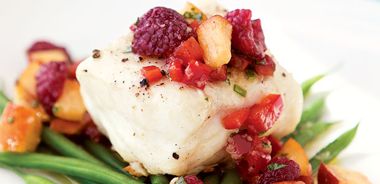Grilled Halibut with Camelina Fruit Salsa

Cold-pressed camelina oil is ideal for searing fish and its high smoke point makes it easy to use on the grill. In salsa, camelina oil keeps things light, fresh, and fragrant.
Halibut
24 oz (680 g) halibut (or white fish of choice), skin on fillets
3 Tbsp (45 mL) camelina oil, divided
Salt and pepper, to taste
Salsa
1 cup (250 mL) diced red pepper
1 cup (250 mL) halved fresh raspberries
1 cup (250 mL) diced fresh peaches
3 Tbsp (45 mL) chopped fresh chives
1 tsp (5 mL) minced fresh ginger root
1 small garlic clove, minced
1 Tbsp (15 mL) fresh lime juice
1 Tbsp (15 mL) maple syrup
2 Tbsp (30 mL) camelina oil
1 Tbsp (15 mL) chopped basil
Salt and pepper, to taste
For halibut, pat fillets dry with paper towel and then massage camelina oil into each fillet (this is your marinade). Season with salt and pepper, cover, and refrigerate.
For salsa, toss all salsa ingredients together in bowl and refrigerate.
Preheat barbecue to medium heat and ensure grill is well oiled to prevent sticking. Place fillets skin side down (the skin helps to prevent sticking as well). Do not flip fillets. Instead, just rotate 180 degrees (so the skin side is still down) once, halfway through the cooking period. Fish is best grilled with lid closed so heat is evenly distributed around fillet. To test for doneness, press lightly with your finger in centre—halibut is done when it flakes away from itself, approximately 12 minutes.
Serve fish topped with salsa, along with fresh garden greens or green beans on the side.
Serves 6.
Each serving contains: 275 calories; 26 g protein; 15 g total fat (2 g sat. fat, 0 g trans fat); 10 g total carbohydrates (6 g sugars, 2 g fibre); 292 mg sodium
source: "Cooking with Camelina Oil", from alive #369, July 2013




